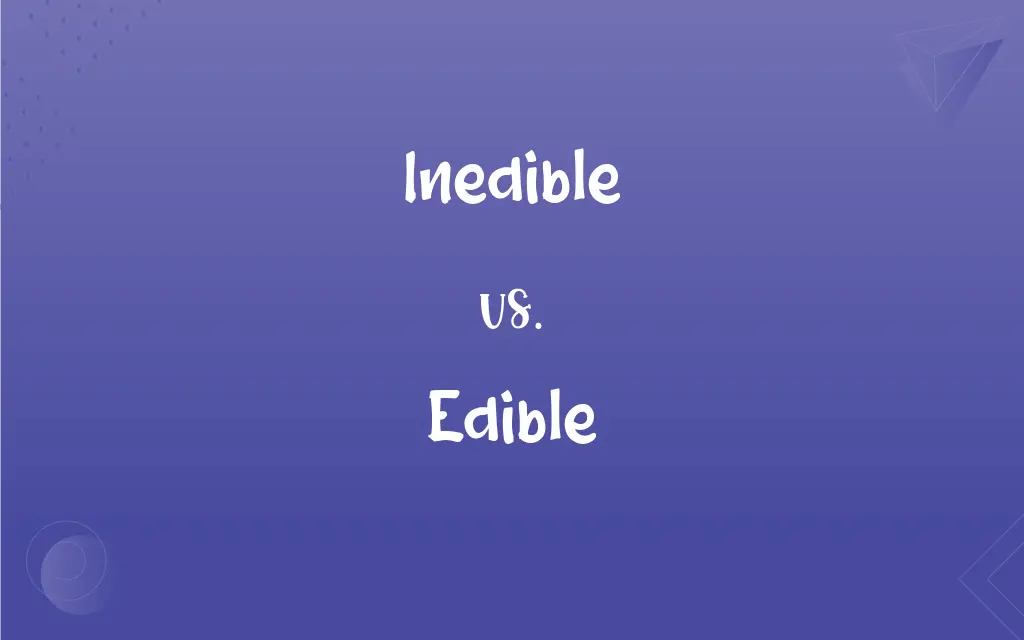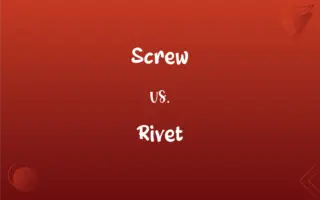Inedible vs. Edible: What's the Difference?
By Aimie Carlson & Janet White || Updated on May 23, 2024
Inedible refers to something that cannot be eaten, while edible describes something that is safe and suitable for consumption.

Key Differences
Inedible items are those that cannot be consumed due to toxicity, spoilage, or being non-food items. This could include poisonous plants or objects like plastic. On the other hand, edible items are safe for consumption and provide nutritional value, like fruits, vegetables, and cooked meat.
Inedible substances might cause harm or discomfort if ingested, as they are not designed for human consumption. For example, cleaning products and certain wild mushrooms fall into this category. Edible substances are intended to be eaten and are often part of regular diets, such as apples or bread.
Inedible foods might include spoiled or contaminated items, which could lead to food poisoning or other health issues. Conversely, edible foods are carefully prepared and handled to ensure they are safe to eat, such as pasteurized milk or freshly baked cookies.
Inedible also applies to parts of otherwise edible plants or animals, like the seeds of some fruits or bones in meat, which are not meant to be eaten. Edible parts, however, are those that can be safely consumed, like the flesh of the fruit or the meat itself.
Comparison Chart
Definition
Cannot be eaten
Safe and suitable for consumption
ADVERTISEMENT
Safety
Harmful or toxic if ingested
Safe to eat and provides nutrition
Examples
Plastic, poisonous plants
Fruits, vegetables, cooked meat
Preparation
Not prepared for consumption
Prepared to ensure safety and taste
Food Parts
Non-consumable parts of foods
Consumable parts of foods
Inedible and Edible Definitions
Inedible
Cannot be consumed without harm.
Some mushrooms are inedible and extremely toxic.
ADVERTISEMENT
Edible
Provides nutritional value.
Edible plants are a vital part of many diets.
Inedible
Non-food items.
The plastic toy is clearly inedible.
Edible
Suitable for eating.
The salad contained a variety of edible flowers.
Inedible
Not suitable for eating.
The wild berries were inedible and could cause illness.
Edible
Safe to consume.
Only the ripe berries are edible.
Inedible
Parts of food that are not consumable.
The seeds of some fruits are inedible.
Edible
Fit to be eaten, especially by humans
Edible roots.
An edible mushroom.
Inedible
Spoiled or contaminated food.
The bread was moldy and inedible.
Edible
Something fit to be eaten; food
Edibles such as vegetables and meat.
Inedible
Unfit to be eaten; not edible.
Edible
Capable of being eaten without harm; suitable for consumption; innocuous to humans.
Edible fruit
Inedible
Not edible; not appropriate, worthy, or safe to eat
Edible
Capable of being eaten without disgust.
Although stale, the bread was edible.
Inedible
Anything inedible; that which is not a foodstuff.
Edible
In which edible plants are grown for human consumption.
Inedible
Not edible; not fit for use as food.
Edible
Anything edible.
Inedible
Not suitable for food
Edible
In particular, an edible mushroom.
Edible
(marijuana) a foodstuff, usually a baked good, infused with tetrahydrocannabinol from cannabutter etc.
Edible
Fit to be eaten as food; eatable; esculent; as, edible fishes.
Edible
Any substance that can be used as food
Edible
Suitable for use as food
Edible
Parts of food meant to be eaten.
The flesh of the avocado is edible.
Edible
Prepared to be safe for eating.
The chef ensured all the ingredients were edible.
FAQs
Can spoiled food be considered inedible?
Yes, spoiled food is inedible because it can cause health issues.
What does inedible mean?
Inedible means something cannot be eaten safely.
Can something be both inedible and edible?
Parts of an item can be inedible while others are edible, like fruit seeds versus fruit flesh.
Are all parts of edible plants safe to eat?
No, some parts like seeds or stems might be inedible.
Is edible always related to food?
Yes, edible specifically refers to items safe for eating.
Are there edible flowers?
Yes, some flowers are edible and used in cooking.
Are all inedible things harmful?
Not all, but most inedible items can cause harm or discomfort.
How can I tell if something is inedible?
Research or ask experts; signs of spoilage or warnings on packaging can also indicate inedibility.
Is edible food always nutritious?
Generally, yes, but nutritional value can vary.
Can inedible items be toxic?
Yes, many inedible items are toxic if ingested.
What makes something edible?
Being safe for consumption and providing nutritional value makes something edible.
What happens if I eat something inedible?
It can cause illness, discomfort, or poisoning.
Why are some food parts inedible?
Some parts may contain toxins or be too hard to digest.
Can cooking make inedible items edible?
In some cases, like certain wild plants, cooking can make them safe to eat.
Can inedible items be used in cooking?
They shouldn't be used in cooking as they are unsafe to eat.
Do inedible items always taste bad?
Not necessarily, but they are not meant to be tasted.
Is all food prepared by chefs edible?
Yes, chefs prepare food to ensure it's edible.
Why is it important to know what's inedible?
To avoid health risks and ensure safe consumption.
Are edible and organic the same?
No, edible refers to safety for consumption, while organic refers to how food is grown.
Are all wild plants inedible?
No, but many wild plants can be inedible or toxic.
About Author
Written by
Aimie CarlsonAimie Carlson, holding a master's degree in English literature, is a fervent English language enthusiast. She lends her writing talents to Difference Wiki, a prominent website that specializes in comparisons, offering readers insightful analyses that both captivate and inform.
Co-written by
Janet WhiteJanet White has been an esteemed writer and blogger for Difference Wiki. Holding a Master's degree in Science and Medical Journalism from the prestigious Boston University, she has consistently demonstrated her expertise and passion for her field. When she's not immersed in her work, Janet relishes her time exercising, delving into a good book, and cherishing moments with friends and family.































































